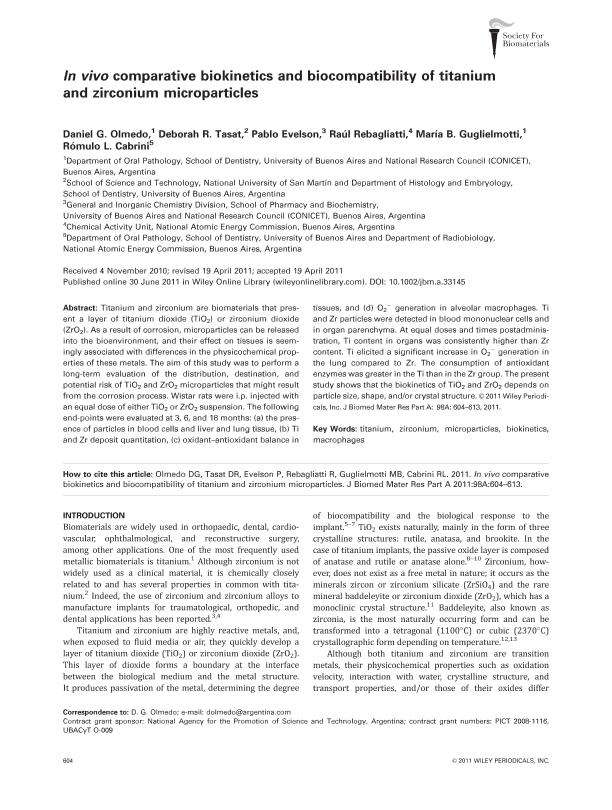Artículo
In vivo comparative biokinetics and biocompatibility of titanium and zirconium microparticles.
Olmedo, Daniel Gustavo ; Tasat, Deborah R.; Evelson, Pablo Andres
; Tasat, Deborah R.; Evelson, Pablo Andres ; Rebagliatti, Raúl; Guglielmotti, Maria Beatriz
; Rebagliatti, Raúl; Guglielmotti, Maria Beatriz ; Cabrini, Rómulo L.
; Cabrini, Rómulo L.
 ; Tasat, Deborah R.; Evelson, Pablo Andres
; Tasat, Deborah R.; Evelson, Pablo Andres ; Rebagliatti, Raúl; Guglielmotti, Maria Beatriz
; Rebagliatti, Raúl; Guglielmotti, Maria Beatriz ; Cabrini, Rómulo L.
; Cabrini, Rómulo L.
Fecha de publicación:
09/2011
Editorial:
Wiley
Revista:
Journal Of Biomedical Materials Research Part A
ISSN:
1549-3296
Idioma:
Inglés
Tipo de recurso:
Artículo publicado
Clasificación temática:
Resumen
Titanium and zirconium are biomaterials that present a layer of titanium dioxide (TiO(2)) or zirconium dioxide (ZrO(2)). As a result of corrosion, microparticles can be released into the bioenvironment, and their effect on tissues is seemingly associated with differences in the physicochemical properties of these metals. The aim of this study was to perform a long-term evaluation of the distribution, destination, and potential risk of TiO(2) and ZrO(2) microparticles that might result from the corrosion process. Wistar rats were i.p. injected with an equal dose of either TiO(2) or ZrO(2) suspension. The following end-points were evaluated at 3, 6, and 18 months: (a) the presence of particles in blood cells and liver and lung tissue, (b) Ti and Zr deposit quantitation, (c) oxidant-antioxidant balance in tissues, and (d) O(2)(-) generation in alveolar macrophages. Ti and Zr particles were detected in blood mononuclear cells and in organ parenchyma. At equal doses and times postadministration, Ti content in organs was consistently higher than Zr content. Ti elicited a significant increase in O(2)(-) generation in the lung compared to Zr. The consumption of antioxidant enzymes was greater in the Ti than in the Zr group. The present study shows that the biokinetics of TiO(2) and ZrO(2) depends on particle size, shape, and/or crystal structure.
Palabras clave:
Titanium
,
Zirconium
,
Microparticles
,
Biokinetics
Archivos asociados
Licencia
Identificadores
Colecciones
Articulos(OCA HOUSSAY)
Articulos de OFICINA DE COORDINACION ADMINISTRATIVA HOUSSAY
Articulos de OFICINA DE COORDINACION ADMINISTRATIVA HOUSSAY
Citación
Olmedo, Daniel Gustavo; Tasat, Deborah R.; Evelson, Pablo Andres; Rebagliatti, Raúl; Guglielmotti, Maria Beatriz; et al.; In vivo comparative biokinetics and biocompatibility of titanium and zirconium microparticles.; Wiley; Journal Of Biomedical Materials Research Part A; 98A; 4; 9-2011; 604-613
Compartir
Altmétricas



